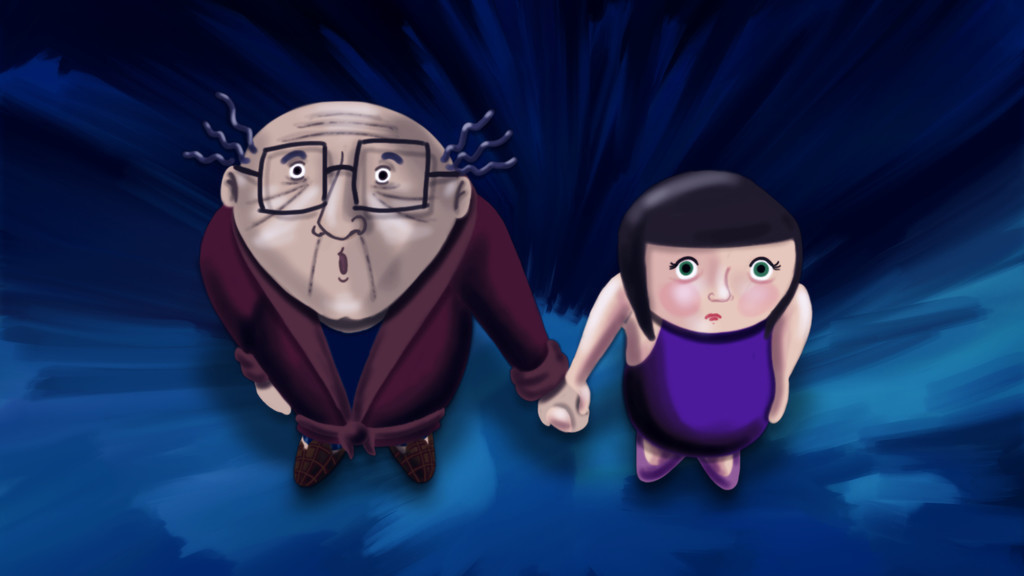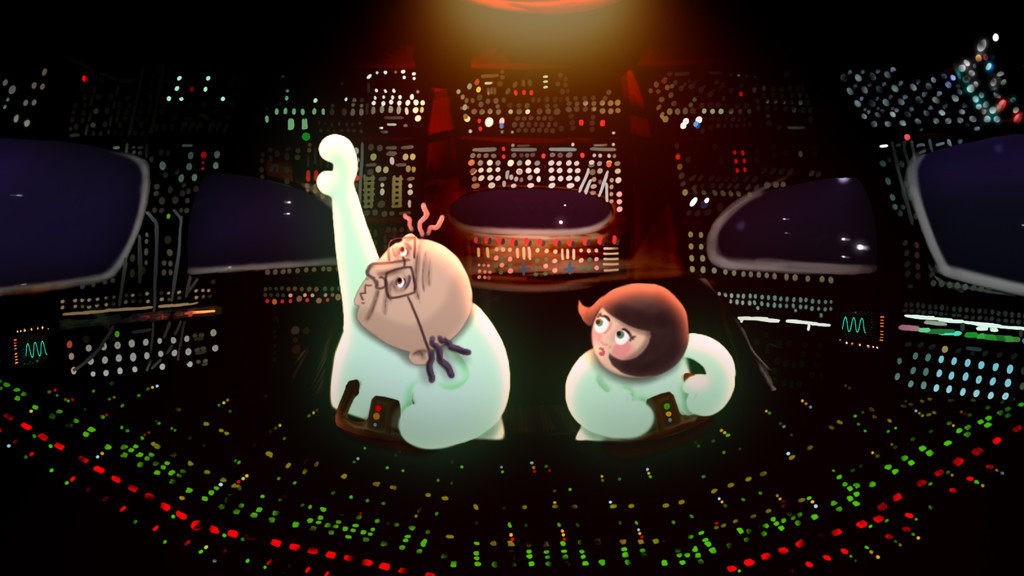
Case Study: A Space in Time
Alexandre Athané about his second short animation A Space in Time.
Geplaatst op 24 maart 2017Alexandre Athané gives us a detailed insight in making his second short animation A Space in Time.
“Never give up on your idea, tell a great story, hang on tight and be patient and a hard worker. And make sure to breathe, it’s part of the work too!”
The idea
“I had animated the opening titles on Max, a French feature-film, co-written by director Stéphanie Murat and scriptwriter Vincent Cappello. A few years later, they approached me with a short live action script by Vincent called L’Espace d’un Instant, meant for live action actors. When I read it, I was amazed: it was in many ways the story of my own grandfather whose dream was to see the first man walk on the moon. He had bought a television to see the event on TV, and unfortunately passed away one week before. This story was always dear to me and my mum, and when Vincent brought his script about a little girl and a grandfather dreaming to go to space, there was no doubt it was a script for me to make into an animated movie.”
The reading- and drawing-process
“The script was originally written as a live action film with actors. I read it and turned it into a storyboard, and then became free around it as I drew. I got rid of archives images that were described originally, and added many details, like the seasons, and visually interpreted many scenes as metaphorical. Thus, many things you see in the film were not described in the script. The script was mainly a discussion between two characters without details. There were also more characters in the original story, but I kept only two, in order to be able to animate and focus on them two. Basically, the original script helped me as a doted line to be free around and let my imagination go as I drew.”
“I read the original script really quickly in a silent room, sitting at my desk, and knew instantly I wanted to direct it. I thought of it unconsciously and consciously for the next few days, drew sketches of things that popped up in my mind in my notebook with a black pen listening to music, and then one day, in silence, sat at my desk and drew a very quick storyboard from A to Z, in the same note book, on stamp-size windows, translating the text and my imagination into quick drawings. In what seemed a timeless evening, the film was thought of entirely and visually laid on paper, right there, in the quick black and white storyboard.”
“When I deal with words and reading, I always do it in a silent environment. When I draw freely, I do it with music, and a lot of film scores playing. But when I animate characters, I tend to force myself and stop the music as it is important to keep the rhythm of the character you animate your main focus, and not the rhythm of the music in the background distracting the animation you are making.”

The production
“The script had already been granted a small grant years before in a film script festival. Certainly not enough to make a movie, especially not an animated movie, but just enough to keep me started, thanks to my producers. So I just started drawing while I told my producers to go look for more money. I didn’t want to wait for good or bad news from institutions, as animation is such time consuming. I thought I better start drawing, as I couldn’t wait to start making the film. I thought: ‘Bring the good news as I draw, you have time to look for money, and I won’t stop until the film is done no matter what.'”
“I didn’t want to wait for good or bad news from institutions.”
“Because of an almost non-existent budget and because of my impatience, I didn’t have to look for extra crew, as I did everything by myself for over a year and a half. However, from day one I had told my producers three crew members were going to be essential at the end of production: a music composer, an after-effects technician, and a sound-mix technician. I knew the people I wanted to work with, so warned them over a year and a half before they started work that we would call them at some point later on. So part of the money search was with that in mind, and to make sure we could pay this small essential crew when the drawings and animation would be completely done.”
“Voices for the characters would be recorded after the film was totally finished and edited. So the small budget also allowed us to hire voice actors. My producers made it possible to hire the fantastic French actor Pierre Richard and the film composer Alex Beaupain, and they organized a casting of children for the voice of the little girl. In the end, the production for me was very lonely most of the time, very satisfying sometimes, never ending often, an adventure everyday and a work of passion always!”
“The production for me was very lonely most of the time, very satisfying sometimes, never ending often, an adventure everyday and a work of passion always!”
Planning and financing
My producers applied for funding. I fed them with drawings, animatics and sketches all along, and basically, they really started looking for funding after one-year work on my part. At first, just the Region Picardie in France had funded the original script by Vincent Cappello. Then, a year later, the producers approached the CNC, and a TV channel, Gulli, who agreed to co-finance the film. I brought all the equipment and my own studio into the process, from day one, and my software monthly subscription. Thinking of this, I could have been credited as an executive producer or something.”
“I was very, very and meticulously organized myself, but needed someone to look after me and help me on the longer term.”
“The hardest thing for me was to determine the time it would take me to make the film. At first I had imagined I would make a black and white animation, and that it could take me 6 months. This is what I had told my producers. And then while creating my backgrounds layouts, I started adding colors and feeling good about creating a very colorful world, the one you see in the film. A few months later I then had to make the animation and put moving characters onto these very rich and detailed backgrounds, and since I was alone to animate and color, I suddenly realized it would be hard and long to do the characters … Basically, from 6 months announced it became two years. But Marie Etchegoyen, a new producer, arrived onboard after one-year work, and she organized the planning for me very well, which helped me anticipate and set my goals a bit further than just day-to-day. I was very, very and meticulously organized myself, but needed someone to look after me and help me on the longer term. I will make sure to surround myself with the right planning people from day one, on the next project.”

Teamwork
“In the end, everything went according to the plan. I knew exactly where I was taking the project, and since most of it was up to me, it was really up to me to work, work, work. When things went wrong, nothing could go wrong enough to make me give up. In the end, I had to make this film. I learned that no one has to be as passionate about the project than me, that I cannot ask anyone to be as available, as perfectionist as me. People have a life, a family, and so it is great when they give time, and i have to be grateful for this. Working with the musician, with the actors and the sound guys was a delight, because they arrived over one year and a half after I had started animating. They were cherries on the cake, and all I had to do was share my ideas and let them surprise me. They actually were on my mind all the way throughout my many months sitting at my desk drawing: I was so looking forward to my collaboration with them. All the time I was thinking I had to give them the best of me now, for the moment they would start their part of the job then.”
“I had to make this film.”
Post-production and distribution
“A young editor, Camille Adelin, worked on the editing. As far as animation goes, editing is already thought of as soon as the storyboard is created. There is very few seconds of animation that you don’t use when editing. But it is very surprising to let your film in the hands of an editor, because he can do wonders. And Camille did. I let him work by himself a few days, and he helped me take a distance from the project and see it under a new light, a new angle.”
“Original music is part of my passion of filmmaking. I met composer Alex Beaupain only twice. The first time, one year into the animation process, to present him with the project in many details, with a animated demo, and see if he would agree to work with me. And the second time, eight months later, for music recording of the score, at his music studio. In between we had very rare exchanges of mails and text messages. Just four days before entering the studio, Alex sent me a demo. I asked him to cut a few things or replace a few others, and we were set for entering the studio. I trusted him that he understood my ideas and directions and I was very confident that he would do a great work.”
“The film was completed late 2015, and has since gone to about 60 screenings, events or festivals so far, in France and abroad. It was part of the Pierre Richard Retrospective at the French Cinematheque and La Fête de l’Humanité in France. It has won 9 awards so far, in Ukraine, Russia, South Africa, New York, Nevada, Spain, England, Greece and Alaska. It is also being showed on French TV Gulli who owns the rights for one more year in France. When I have the chance to travel to festivals to present the film, I happily introduce it to the audiences and speak with people about it. Meeting people is the most beautiful thing! I did not have any problems with festivals, just my Ukrainian award that got lost in the post, but was finally found and arrived safely, thank god, as it is so beautiful!”
And a last tip for filmmakers from Alexandre: “Never give up on your idea, tell a great story, hang on tight and be patient and a hard worker. And make sure to breathe, it’s part of the work too!”
“I trusted him that he understood my ideas and directions and I was very confident that he would do a great work.”